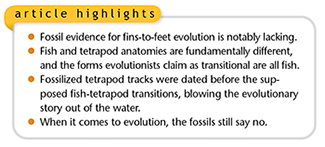 One of the alleged greatest transformations in vertebrate evolution is said to be the emergence of creatures that traded fins for feet and transitioned from water to land.1-3 In other words, fish somehow evolved the numerous anatomical and physiological systems found in four-legged amphibians and various land-based reptiles. Despite evolutionary propaganda surrounding unusual fish-like creatures discovered in the fossil record, the necessary evidence of such a monumental evolutionary leap is profoundly lacking.
One of the alleged greatest transformations in vertebrate evolution is said to be the emergence of creatures that traded fins for feet and transitioned from water to land.1-3 In other words, fish somehow evolved the numerous anatomical and physiological systems found in four-legged amphibians and various land-based reptiles. Despite evolutionary propaganda surrounding unusual fish-like creatures discovered in the fossil record, the necessary evidence of such a monumental evolutionary leap is profoundly lacking.
In 2012, Jennifer Clack, one of the most famous vertebrate paleontologists of the modern era, concluded, “The question of where tetrapods evolved is even more difficult to answer than that of when.”1 Echoing this frustration, a 2018 research paper stated, “The fish-to-tetrapod transition is one of the fundamental problems in evolutionary biology.”4
The alleged fins-to-feet evolutionary transformation is thought to have brewed during the deposition of Devonian strata, which I described in a previous article as the geological period known as the Age of the Fishes—a point in the rock record when numerous types of unique fish show up suddenly with no evolutionary precursors.5 The supposed transition from water to land would have required the evolution of many novel structures in skeletons, musculatures, neural systems, internal organs, sensory networks, and respiratory systems.1-4
Anatomically speaking, specialized appendages and skeletons along with associated musculatures would need to have formed to support a creature’s body weight against gravitational forces to allow it to move on land. In contrast, fish are highly specialized to live buoyantly in the water, largely avoiding the effects of gravity on movement.
Furthermore, to facilitate respiration, gill breathing would have needed to transform into lung breathing—a radical physiological change in itself—through other highly specialized innovations.
Are Lobe-Finned Fishes Tetrapod Ancestors?
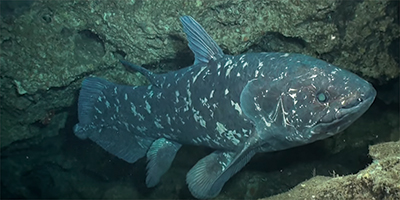
Lobe-finned fishes (sarcopterygians) are bony and scaly fish with fleshy, lobed, paired fins that are connected to the body by a single bone. Their fins are different from those of other scaly fish in that each one is borne on a fleshy, lobe-like stalk. Because of this unique extended fin structure, evolutionists have eyed this feature as a potential limb “looking” to evolve into arms, legs, hands, and feet.1-4 Many sarcopterygians also have two dorsal fins with separate bases compared to the single dorsal fin found in ray-finned fishes. In reality, sarcopterygians simply represent a unique category of fishes with unique features.
Lobe-finned fishes first appear suddenly at the beginning of the Devonian rocks along with many other types of fish (jawless, jawed, armored, spiny, and cartilaginous) with no evolutionary precursors.6 Two living examples of these types of fish are the coelacanth (Figure 1) and the lungfish. The oldest coelacanth fossil is dated by evolutionists at about 408 Ma (millions of years ago), and the youngest is found in rock layers conventionally dated as about 66 Ma.6 While the coelacanth was originally thought to have been extinct, we now know that it’s alive and well and adapted to live deep in the ocean. Off the coast of South Africa, it’s found between 500 and 2,300 feet below the surface. Obviously, this fish so deep in the ocean is far from the possibility of evolving to roam on land.
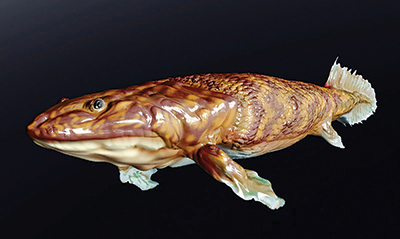
Evolutionists have picked the extinct lobe-finned fish called Panderichthys (Figure 2) as the main basal candidate leading to a terrestrial creature in the evolutionary tree. Fossils of this sarcopterygian don’t appear until the Late Devonian system, claimed to be 380 Ma. Because of its lobe-finned anatomy and other features, like a more flattened head and a lack of dorsal fins, it had a crude four-limbed (tetrapod)7 appearance similar to some amphibians, although its rear fins (where hind legs should be evolving) were very small. Thus, evolutionists have placed this as one of the first fish on the path to living on land.
Tiktaalik
Next up the ladder is Tiktaalik, claimed to be 383 Ma, a rock star in evolutionary circles and held up as one of the most important transitions to a land-dwelling creature (Figure 3).1-3 For all practical purposes, Tiktaalik was just another unique type of lobe-finned fish similar to its supposed evolutionary precursor Panderichthys in many features. It had fishy body scales, fin rays, gills, and a lower jaw like Panderichthys. However, it did have a slight separation between its head and shoulder region, allowing more head movement. The forelimb had more joints than Panderichthys, providing more fin movement, and the pelvic girdle was enlarged and more elaborate. It’s believed that Tiktaalik may have pushed itself up onto land like mudskippers do today—although this is purely speculation.
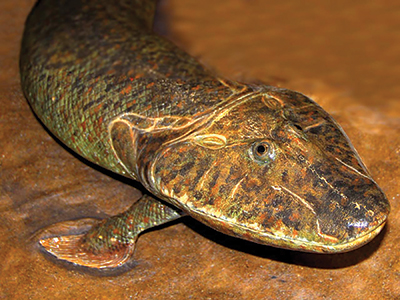
Furthermore, Tiktaalik’s lobe-fins were still fish-like, so these structures could not have supported its weight on land. It was clearly adapted to live in water or in a swampy environment. Clack noted these obvious fish fins and said, “The paired fins of Tiktaalik still retain fin rays: Loss of fin rays is part of the way in which limbs are distinguished from fins.”8 While having some interesting traits, Tiktaalik was simply a unique kind of fish that was incapable of living and walking on land.
Acanthostega
The next main candidate above Tiktaalik on the evolutionary tree is Acanthostega, claimed to be 365 Ma, found in Late Devonian sediments (Figure 4).1-3,8 Although it exhibited a number of distinct fish-like features, evolutionists have claimed it was nevertheless an early tetrapod by the definition of having limbs with digits.8 Acanthostega also had an enlarged pelvic girdle and was differently structured than Tiktaalik, but it was still relatively small compared to land-walking tetrapods and was connected to the vertebral column by soft tissue rather than a bony junction. Some of the other prominent fish-like features of Acanthostega included a tail fin supported by long bony rays and internal covered gills (like fish), clearly indicating it was an underwater gill breather.8 Its shoulder and forelimb were also distinctly fish-like.
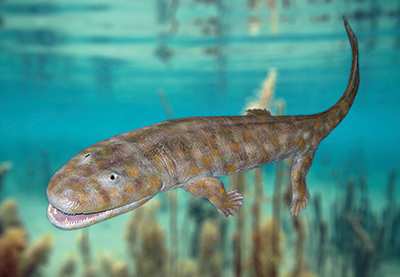
For evolutionists, the discovery and analysis of Acanthostega were as much a blessing as a curse. It was one of the first fish-like creatures found that had seemingly recognizable appendages with digits, eight digits on the front “feet” and six on the back. However, the controversy centered around the fact that the standard number of digits for land-based tetrapods is five. Furthermore, the eight front digits were linked by webbing, creating functional paddle fins, and the limbs lacked wrists, which would keep it from walking on land. In other words, its front appendages couldn’t bend forward at the elbow, and thus the creature couldn’t have achieved a weight-bearing position.
Clearly, this creature had its limbs and digits adapted for swimming and also perhaps for grasping aquatic plants. Once again, we have another unique type of extinct fish with no real hope of being terrestrial. In fact, Clack interpreted Acanthostega as an aquatic animal that never left the water.8
Ichthyostega
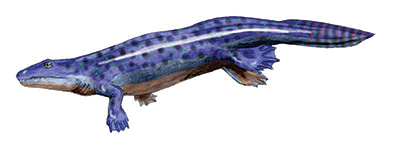
The last alleged key tetrapod transitional creature in the evolutionary tree is Ichthyostega, claimed to be 370 Ma—5 Ma older than Acanthostega, its supposed precursor (Figure 5). Like Acanthostega, this creature had features showing it was well-adapted to life in the water. Such fish-like features included fully functioning gills (even as adults) and a fin containing fin rays on its tail.1-3,8 Compared to its supposed evolutionary precursors, it had more elaborate limbs, but they were not suited to walking on land. Research manipulating its limb bones in computer models showed there was almost no long axis rotation of the humerus and femur; the animal couldn’t stand or turn its hand or foot flat to the ground.9 Therefore, it couldn’t have pushed its body off the ground or moved its limbs in an alternating sequence as typical land-walking tetrapods can.
Other features of Ichthyostega are also confusing from an evolutionary perspective, leading Clack to admit this was a “problematic genera.”1 The design of the vertebral column was found to be unexpectedly different based on anticipated evolutionary assumptions.10 The digit count on its rear limb was seven as opposed to eight for Acanthostega or the standard five for most tetrapods. The strange hodgepodge of traits in this fish-like creature led Clack to state, “Ichthyostega, far from being representative of a Devonian tetrapod, turns out to be highly specialized in its own way.”8 Thus, while Ichthyostega was a unique fish-like creature with an interesting mosaic of unusual traits, it fails to fit the role of a water-to-land transitional form.
A Water-to-Land Transition Is Still Missing
After Ichthyostega, any other transitional form candidates simply disappear in the rock record, as noted by Clack: “The fossil record of post-Devonian tetrapods is notoriously sparse for about 30 million years after the Devonian/Carboniferous (Mississippian system) boundary.” Clack also states, “The origin of limbed tetrapods did not coincide with the acquisition of full terrestriality, an outcome that probably arose in the Early Carboniferous. This latter part of the story is documented by few fossils.”8
In other words, the huge evolutionary gap between water and land still exists with no fossil solution in sight. Renowned vertebrate paleontologist Michael Benton acknowledges this fact with the hopeful statement “Perhaps fully terrestrial tetrapods emerged only 25 Ma later in the Carboniferous.”2
Perhaps?
Ancient Tracks Derail Tetrapod Evolution
If a complete lack of transitional forms for water-to-land tetrapod evolution weren’t enough, the biggest deal breaker in this whole story is one of dating. All of the key fossils discussed in this article leading up to a missing terrestrial transition are assigned to a very short period in the Middle-Upper Devonian (385-365 Ma).1-3,8 Not only is a 20 Ma window a very short time for all of this purported evolution to occur, but a fairly recent discovery has made the conundrum even greater.
In 2010, it was reported that well-preserved and “securely dated” land-walker tetrapod tracks from an ancient Polish marine tidal flat were found that were supposedly 397 Ma.11 These well-preserved fossil tracks suggest that a group of two-meter-long terrestrial tetrapods lived near the south coast of Laurussia (a section of the ancient pre-Flood Pangaea supercontinent) that “were walking” with “stout legs.”
Since these tracks would have been made before any of the creatures discussed in this article ever existed, the whole tetrapod evolutionary story is void of any evidence whatsoever. The authors of the 2010 study said, “[The tracks] force a radical reassessment of the timing, ecology and environmental setting of the fish-tetrapod transition, as well as the completeness of the body fossil record.”12 After Clack reviewed the timing of the Polish tetrapod tracks, she admitted in the newspaper The Guardian, “It blows the whole story out of the water, so to speak.”12
Conclusion
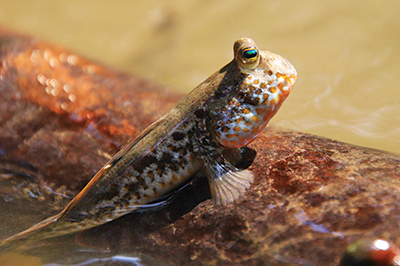
This series of fossil fish-like creatures that supposedly represent the evolution of something that could eventually transition to live on land offers little substance to solve the evolutionary story—it rather blurs it. In fact, the confusing mixture of traits these fish-like creatures possessed and the problems it gave evolution were noted by Clack: “Depending on which characters were ordered versus unordered and which taxa were included or excluded, different results were obtained. In other words, the phylogeny of Devonian tetrapods was unstable.”1
But the ultimate death knell for the evolutionary story is that fully terrestrial tetrapod tracks were found in rocks dated older than when any of these so-called transitional forms supposedly existed.
When we apply the creationist global Flood model of progressive burial by ecological zonation, the presence of these unusual fish-like fossils makes perfect sense.13 Since these creatures were buried in the Flood layers shortly before most coastal land plants appear in the Carboniferous, it becomes apparent that they likely inhabited coastal waters based on their various unique adaptations and their place of burial in the Flood strata. When it comes to the evidence, the fossils say no to tetrapod evolution.
Click here for other articles in The Fossils Still Say No series.
References
- Clack, J. 2012. Gaining Ground: The Origin and Evolution of Tetrapods. Bloomington, IN: Indiana University Press.
- Benton, M. J. 2015. Early Tetrapods and Amphibians. In Vertebrate Paleontology. West Sussex, UK: John Wiley & Sons Ltd.
- Dial, K. P., N. Shubin, and E. L. Brainerd. 2015. Great Transformations in Vertebrate Evolution. Chicago, IL: University of Chicago Press.
- Wood, T. W. P. and T. Nakamura. 2018. Problems in Fish-to-Tetrapod Transition: Genetic Expeditions Into Old Specimens. Frontiers in Cell and Developmental Biology. 6: 70.
- Tomkins, J. P. 2021. The Fossils Still Say No: The Mystery of Jawed Vertebrates. Acts & Facts. 50 (2): 12-14.
- Johanson, Z. et al. 2006. Oldest coelacanth, from the Early Devonian of Australia. Biology Letters. 2 (3): 443-446.
- The term “tetrapod” is from Greek tetra “four” and pous “foot,” which defines four-limbed animals constituting the superclass Tetrapoda. Evolutionists will often label the creatures listed in this article as tetrapods or tetrapodamorphs even though they had no real foot-walking ability.
- Clack, J. A. 2009. The Fish-Tetrapod Transition: New Fossils and Interpretations. Evolution: Education and Outreach. 2: 213-223.
- Pierce, S. E., J. A. Clack, and J. R. Hutchinson. 2012. Three-dimensional limb joint mobility in the early tetrapod Ichthyostega. Nature. 486: 523-526.
- Pierce, S. E. et al. 2013. Vertebral architecture in the earliest stem tetrapods. Nature. 494: 226-229.
- Niedz´wiedzki, G. et al. 2010. Tetrapod trackways from the early Middle Devonian period of Poland. Nature. 463 (7227): 43-48.
- McVeigh, K. Footprints show tetrapods walked on land 18m years earlier than thought. The Guardian. Posted on guardian.co.uk January 6, 2010, accessed January 21, 2010.
- Clarey, T. 2020. Carved in Stone: Geological Evidence of the Worldwide Flood. Dallas, TX: Institute for Creation Research.
* Dr. Tomkins is Director of Research at the Institute for Creation Research and earned his Ph.D. in genetics from Clemson University.




